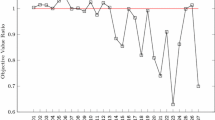Abstract
Manpower still is one of the most expensive resources, in spite of increasing automation. While employee scheduling and rostering has been the topic of extensive research over the past decades, usually it is assumed that the demand for staff is either given or can be obtained without difficulty. In this research we provide an integer programming model for long-term staffing decisions which fits to the needs of manufacturing-to-order companies. The model is based on qualification profiles, the number of which grows exponentially in terms of the number of processes considered. In order to compute tight lower bounds we provide a column generation technique. The subproblem is a shortest path problem in a network where the arcs have multiple weights. Upper bounds, that is, feasible solutions are calculated by means of local search. We present computational results for randomly generated instances and empirical results for examples from practice. The results show that substantial cost savings can be achieved.
Similar content being viewed by others
References
Aarts EHL, Lenstra JK (eds) (1997) Local search in combinatorial optimization. Wiley, Chichester
Abramson D, Dang H, Krishnamoorthy M (1996) A comparison of two methods for soving 0-1 integer programs using a general purpose simulated annealing algorithm. Ann Oper Res 63: 129–150
Ahn H-S, Righter R, Shanthikumar JG (2005) Staffing decisions for heterogeneous workers with turnover. Math Meth Oper Res 62: 499–514
Ahuja RK, Ergun Ö, Orlin JB, Punnen AP (2002) A survey of very large-scale neighborhood search techniques. Discrete Appl Math 123: 75–102
Barnhart C, Johnson EL, Nemhauser GL, Savelsbergh MWP, Vance PH (1998) Branch-and-price: column generation for huge integer programs. Oper Res 46: 316–329
Burke E, Cowling P, de Causmaecker P, Berghe GV (2004) The state of the art of nurse rostering. J Scheduling 7: 441–499
Ernst A, Jiang H, Krishnamoorthy M, Shier D (2004) Staff scheduling and rostering: a review of applications, methods and models. Euro J Oper Res 153: 23–27
Gilmore PC, Gomory RE (1960) A linear programming approach to the cutting-stock problem. Operations Research 9: 849–859
Johnson D, Aragon C, McGeoch L, Schevon C (1989) Optimization by simulated annealing: an experimental evaluation; part I, graph partitioning. Oper Res 37: 865–892
Johnson D, Aragon C, McGeoch L, Schevon C (1991) Optimization by simulated annealing: an experimental evaluation; part II, graph coloring and number partitioning. Oper Res 39: 378–406
Kirkpatrick S (1984) Optimization by simulated snnealing—quantitative studies. J Stat Phys 34: 975–986
Kirkpatrick S, Gelatt C, Vecchi M (1983) Optimization by simulated annealing. Science 220: 671–680
Laarhoven P van, Aarts EHL (1987) Simulated annealing: theory and applications. Reidel, Dordrecht/Holland
Lohnabkommen für die Druckindustrie 2004 (in German)
MacBeth G (1966) Organization and manpower planning. Business Publicatios Ltd., London
Mehrotra A, Murphey KE, Trick MA (2000) Optimal shift scheduling: a branch-and-price approch. Naval Res Logistics 47: 185–200
Minieka E (1978) Optimization algorithms for networks and graphs. M. Dekker Inc., New York-Basel
Mundschenk M, Drexl A (2007) Workforce planning in the printing industry. Int J Product Res 45:4849–4872
Pesch E, Tetzlaff U (2005) Scheduling personnel for press machines in the automotive industry. Pacific J Optim 1: 545–564
Pinedo M (2005) Planning and scheduling in manufacturing and services. Springer, Berlin
Thompson GM, Goodale JC (2006) Variable employee productivity in workforce scheduling. Euro J Oper Res 170:376–390
Tien J, Kamiyama A (1982) On manpower scheduling algorithms. Soc of Ind and Appl Math 24: 275–287
Wijmgaard J (1983) Aggregation in manpower planning. Manage Sci 29: 1427–1435
Author information
Authors and Affiliations
Corresponding author
Rights and permissions
About this article
Cite this article
Drexl, A., Mundschenk, M. Long-term staffing based on qualification profiles. Math Meth Oper Res 68, 21–47 (2008). https://doi.org/10.1007/s00186-007-0192-7
Received:
Revised:
Published:
Issue Date:
DOI: https://doi.org/10.1007/s00186-007-0192-7




